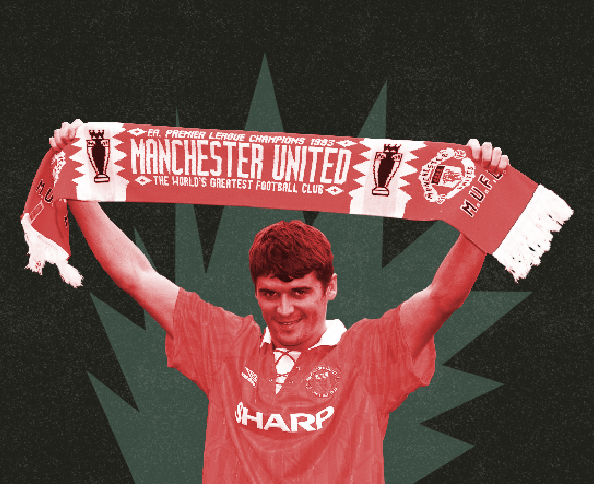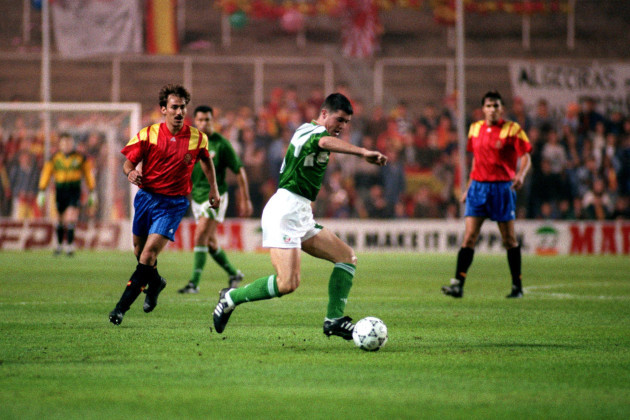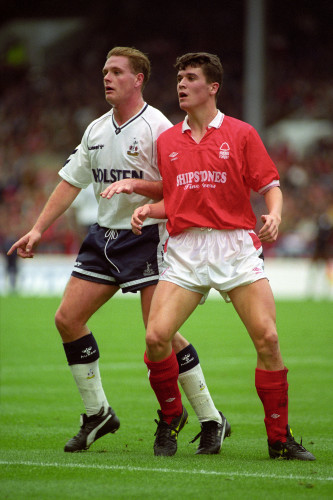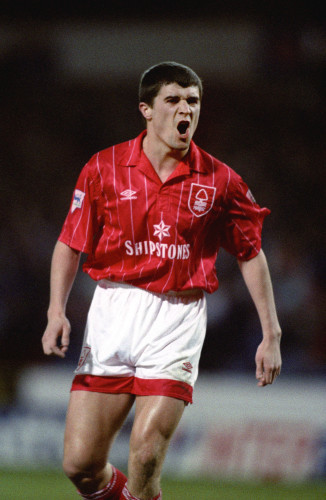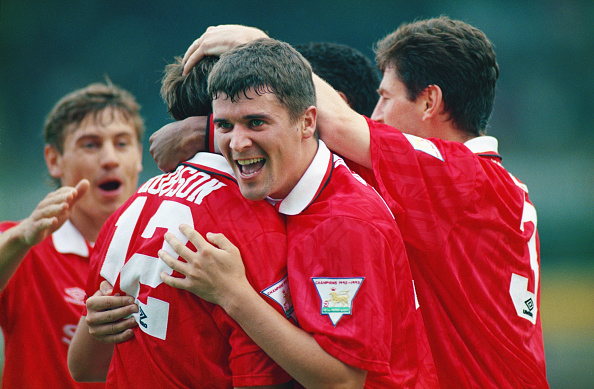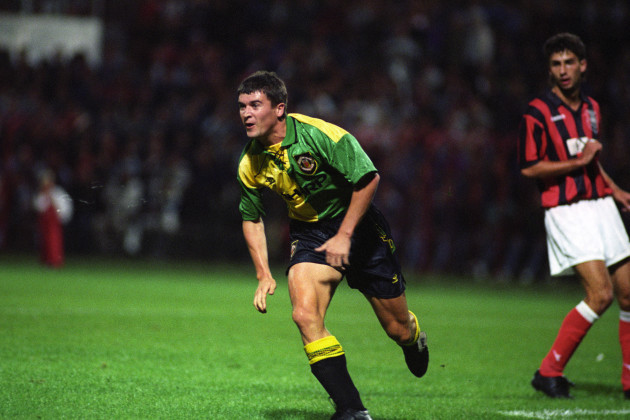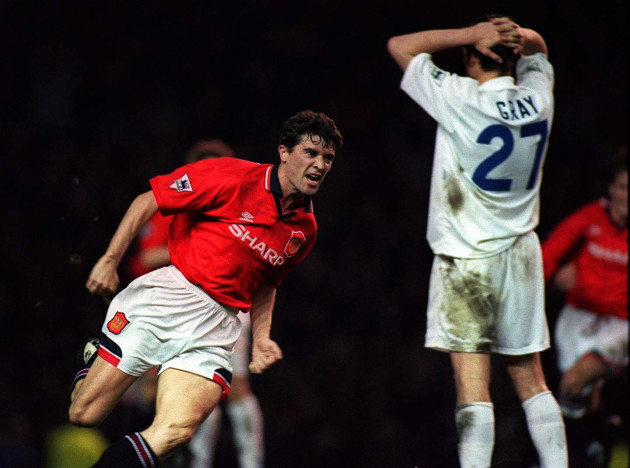LAST UPDATE | 21 Jul 2018
IN DECEMBER 1992, the great Norman Fox wrote a glowing profile of Roy Keane for The Independent.
The piece carried big statements. The Nottingham Forest midfielder was, according to Fox, being tracked by Real Madrid, Sevilla, Barcelona and Milan. He quoted then-England boss Graham Taylor, who felt Keane was ‘the outstanding find of recent years’. In the same paragraph, there were references to the similarities Keane bore to Busby Babe icon Duncan Edwards and another Manchester United legend Bryan Robson. In summation, Fox mentioned Keane’s magnificent performance for his country just weeks earlier and the attention it garnered in unusual places.
Someone who also asked to know more about him when he played so brilliantly for the Republic of Ireland against Spain in a World Cup qualifying game last month was Diego Maradona. ‘He impressed me with everything he did – nobody could touch him that day. He is for the future.’”
The well-worn story is that Keane arrived at United 25 years ago this week as a work in progress and eventually grew into a world-class player. But, it’s easy to forget the calibre of his performances prior to his move to Old Trafford and just how remarkable his ascent was.
Alex Ferguson had been tipped off years earlier when United’s chief scout, Les Kershaw, went on a research trip to watch Forest in September 1990. Brian Clough’s side were due in Manchester a fortnight later and Kershaw phoned Ferguson on his way home.
“I’ve found a player,” he said, with shades of the telegram Bob Bishop sent Busby when he’d seen George Best for the first time in 1961.
Keane had already made his famous Forest debut at Anfield by that stage, thrown in at the deep-end by Clough who’d been impressed enough by his 20-minute runout for the reserves earlier in the week. And when Ferguson saw Keane up close for the first time, he was intrigued.
“His persistence and courage was phenomenal,” he said years later.
And I said, ‘Pffff – this is a player. Even though he annoyed me.”
Keane was still just 19 and it had been less than a year since he made his League of Ireland debut.
Forest won 1-0 that day at Old Trafford but their season was mixed. The league campaign was too inconsistent for too long, only really coming to life in mid-April. There was a run all the way to the FA Cup final only for Tottenham to pip them at Wembley. But it had been an astonishing nine months for Keane, who finished the season with 11 goals in all competitions. He found the net 14 times the following season but even with the expensive acquisition of Teddy Sheringham, Forest finished in eighth again and there was more Wembley disappointment as United beat them in the League Cup decider.
By the time Keane was being profiled in prominent UK newspapers, he was an undoubted star, dragging Forest through a chaotic campaign. What made his contribution all the more staggering was that the club had sold imposing centre-half Des Walker to Sampdoria in the summer of ’92 and inevitably began to leak goals. After an opening day victory over Liverpool they lost six on the bounce, conceding eighteen times in the process. So, Clough turned to Keane for help and parachuted him into defence.
Even in his professional infancy, it was apparent that Keane was a complete footballer. His goals usually came from surging runs into the area but that almost paints him as one-dimensional. There were headers, crisp shots from the edge of the box and also some deft assists. In one game against Norwich, he controlled a long ball on the run, swivelled back inside and curled a superb lofted pass into the path of Nigel Clough who did the rest.
Effectively, Keane was Forest’s playmaker.
Despite having to feature heavily at the back, he still managed to find the net eight times. For a goal-shy Forest (Sheringham had been sold at the start of the season), that was crucial but still not enough and the club was doomed to relegation.
“Roy Keane shone like a beacon through all the gloom of that desolate season”, Clough later wrote in his autobiography.
And yet he was still relatively under-appreciated.
Keane made the PFA Team of the Season but lost out to Ryan Giggs for Young Player of the Year, an accolade the winger had also won twelve months earlier. Keane would get used to being overlooked for individual acclaim, not that he ever sought it out. Regardless, it remains a travesty that Keane had to wait until 2000 before being properly recognised by his fellow professionals.
According to Ferguson, United had been desperately trying to sign Keane for two years and in constant contact with Forest about securing his services.
It was a minor miracle that Robson – the relentless warrior – was still an active member of the United squad in 1993, given the frequency of his injuries in the previous seasons. Ferguson was acutely aware – for quite a while – that he needed a young, energetic presence in the middle of midfield but missed out on Paul Gascoigne in 1988.
In subsequent years, the likes of Mike Phelan and Neil Webb arrived, as did Paul Ince, but none possessed Robson’s wider skill-set. By ’93, Ferguson even began to drop striker Brian McClair into midfield just to offer something different.
But, however desperate United were to land Keane and solve their midfield malaise, they weren’t desperate enough.
Blackburn were also in touch with Forest and offered them a package that totalled around £4m, a sum that would smash the British transfer record. Having sold Nigel Clough to Liverpool for £2.2m, at least Forest’s fall through the trapdoor would be cushioned by cash.
Of course, the rest is history. Keane, who didn’t have an agent at the time and was represented by the PFA in all negotiations, was never made aware of United’s long-term interest. So, he shook hands with Blackburn boss Kenny Dalglish on a Friday and, because everyone at the club had left for the day by the time an agreement was reached, arranged to return on the following Monday to sign the contract.
And it was during the weekend when Ferguson made his famous play, calling Keane and inviting him to his house in Manchester for a chat. He’d read about the imminent deal in the press and when Keane told him on the phone that he hadn’t signed anything yet, Ferguson knew he had a chance. Over a game of snooker, he told Keane how crucial he’d be to the team, particularly as United focused their attentions on Europe. But what stuck with Keane was that Ferguson never mentioned money. During talks with Dalglish, they had negotiated about salary but Ferguson never even brought it up.
The approach may have reminded Keane of Clough, the man who gave him the chance he’d craved for so long. When the Cobh Ramblers contingent flew to Nottingham in 1990, Clough’s assistant Ron Fenton handled discussions. As both parties knocked some figures back and forth, Clough laid down a simple instruction to his lieutenant.
“Pay them the money, Ronnie.”
Years later, when Keane negotiated a new deal with Forest, it was the exact same scenario. Fenton tried to play hardball but Clough entered the room and was adamant that his player should get a decent pay increase, a sizeable signing-on fee and be allowed leave if Forest went down.
“Give him what he wants, Ron” was the familiar direction.
Keane’s transfer to United was still a record deal – £3.75m – which is another element of the story that sometimes gets overlooked. At the age of 21, Keane was the most expensive signing in British football history. He had already amassed quite the fan club before arriving at Old Trafford. He didn’t come cheap. And that was all a testament to his inexplicable rise at Forest and how indispensable he became in such a remarkably short time.
But looking back, some wondered how Keane would fit in to the side. On his home debut, he scored twice against Sheffield United but he was afforded plenty of freedom owing to Eric Cantona’s absence. He played alongside Robson and Ince, with Giggs and Andrei Kanchelskis providing the width.
When Cantona returned, Keane remained but in a largely undefined role. In a Champions League tie with Hungarian outfit Kispest Honved, Keane even wore the number 10 shirt. He scored twice again but was also badly caught out for one of Honved’s goals, a reflection of his uncertainty regarding his position. Later, when United faced Galatasaray, Keane – with the number five on his back – started wide right but became much more instrumental when moved inside and set up Cantona superbly for a late equaliser.
Interviewed by Barry Davies shortly after signing for the club, he was pressed on how he saw himself as a player and the role he’d have in the side.
“I just get up and down and try and get tackles in here and there and try and get the odd goal,” he said.
I’m far from a flair player. I like to think I can get my fair share of goals from midfield and hopefully I can get into double figures this season.”
Keane sounded almost irritated by Davies’ line of questioning, probably because he wondered the same things and it worried him. And it was only when Robson spoke to Keane about calming his on-field persona and curbing his desire to do so much that he properly found his stride. He was measured and controlled and began to trust his ability to make smart choices and deliver a killer pass when necessary. There were some more outstanding assists – notably teeing up Giggs against Everton, McClair against Sheffield Wednesday and Hughes against West Ham. He began to believe in his all-round game, like what happened at Forest.
The following season, he effortlessly dropped to right-back and made such a dramatic transition look so simple. In one game against Ipswich, he set up both United goals from the flank with expert deliveries for Cantona and Paul Scholes. In 1995/96, as the club came to terms with the departures of Ince, Kanchelskis and Hughes and the promotion of the fabled Class of ’92, Keane stepped up and properly began to exert control in the middle of the pitch.
As much as the Champions League semi-final against Juventus in 1999 will always go down as Keane’s greatest performance, he was immense in a number of crucial games during that second double-winning campaign. When United needed to scalp runaway leaders Newcastle at Old Trafford, Keane played a perfect match and shielded the makeshift central defensive partnership of Gary Neville and David May superbly. Later, he also popped up to brilliantly blast home United’s second goal. In the reverse fixture the following March, he was crucial as United smashed and grabbed their way to victory. And, when they were completely out of ideas at home to Leeds in a crucial title run-in fixture and left frustrated by a bizarrely magnificent goalkeeping display from Lucas Radebe (Mark Beeney was sent-off and they had no direct replacement), it was Keane who conjured the decisive moment.
“A priceless goal,” Barry Davies – Keane’s old pal – said in his commentary.
And so it proved.
Within a few weeks, Keane would have his second double in just three years. And he wasn’t even close to hitting his peak.
The42 is on Instagram! Tap the button below on your phone to follow us!
